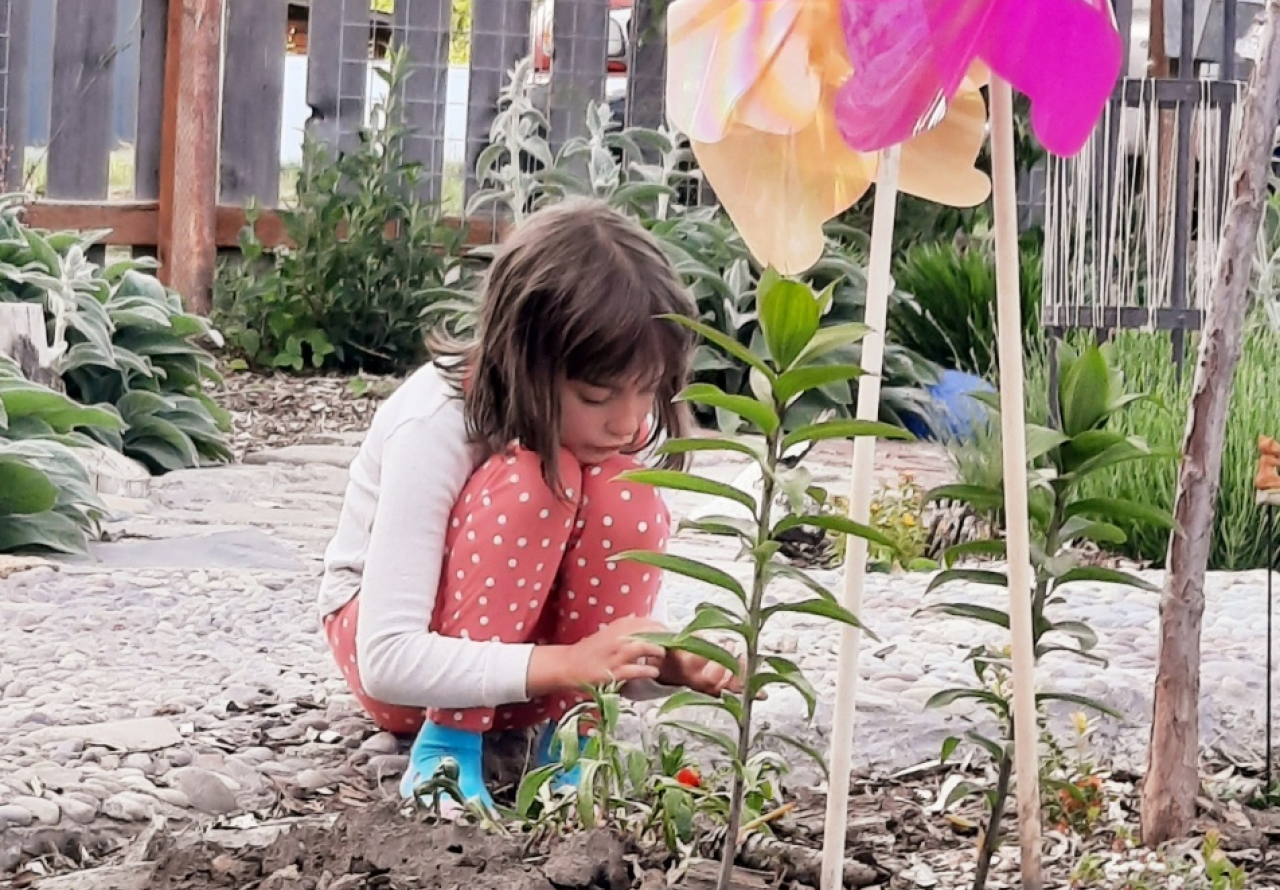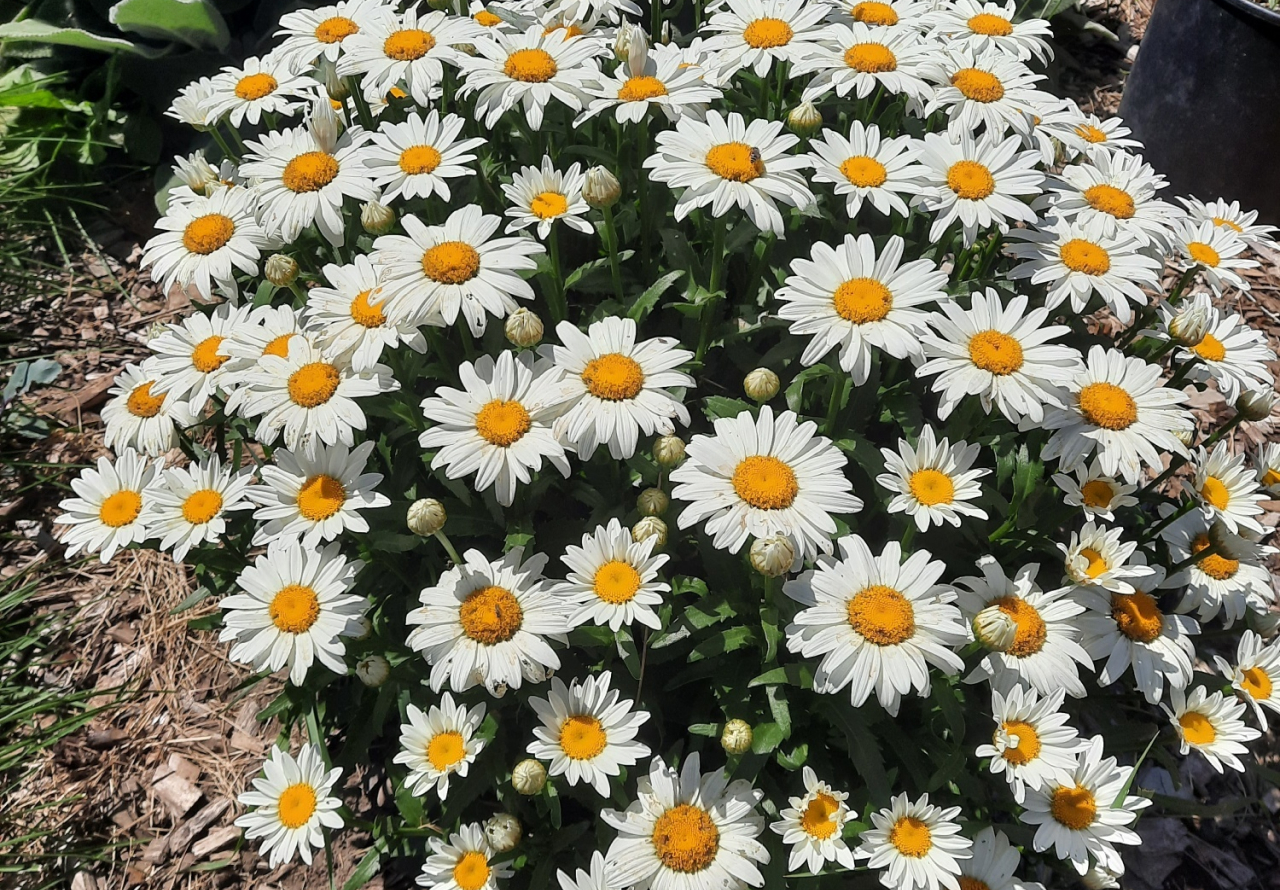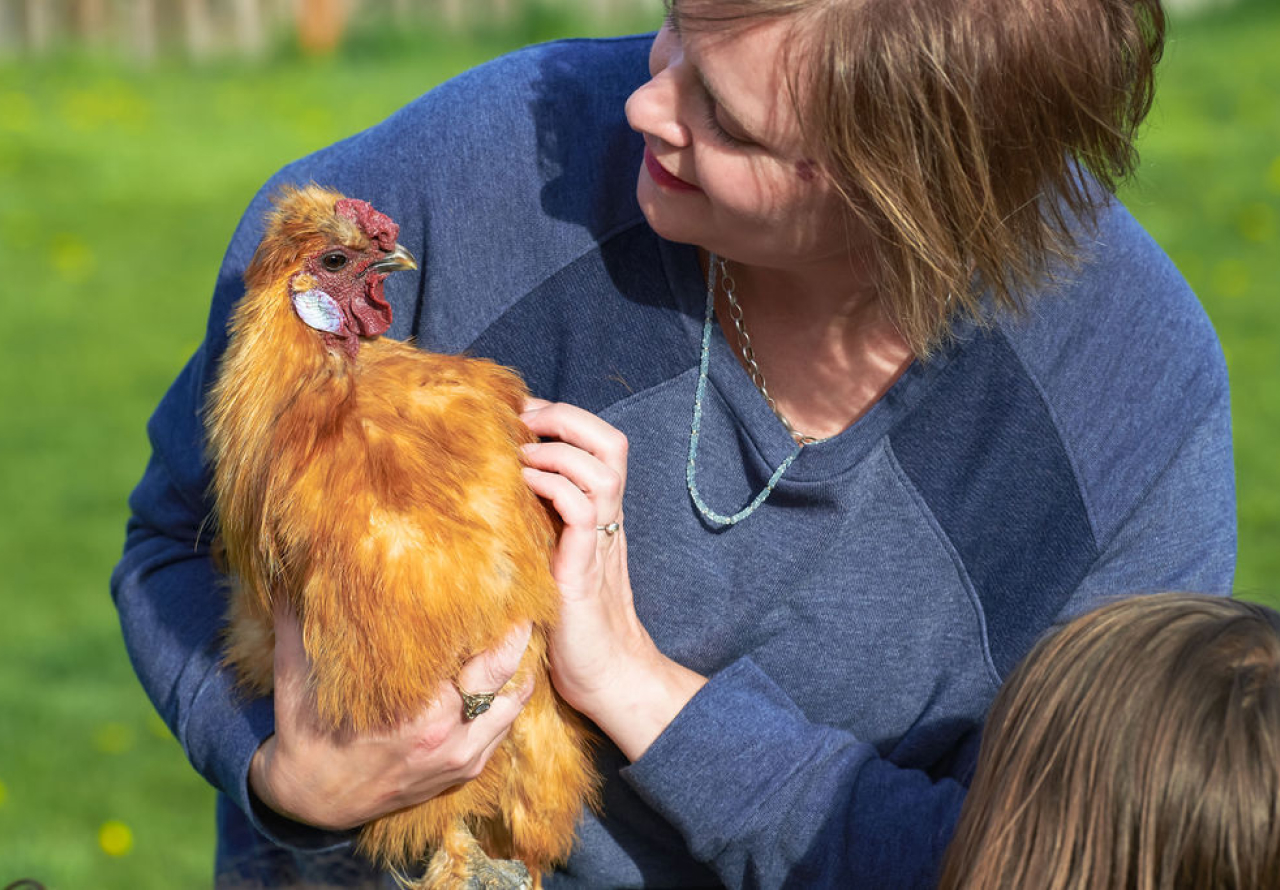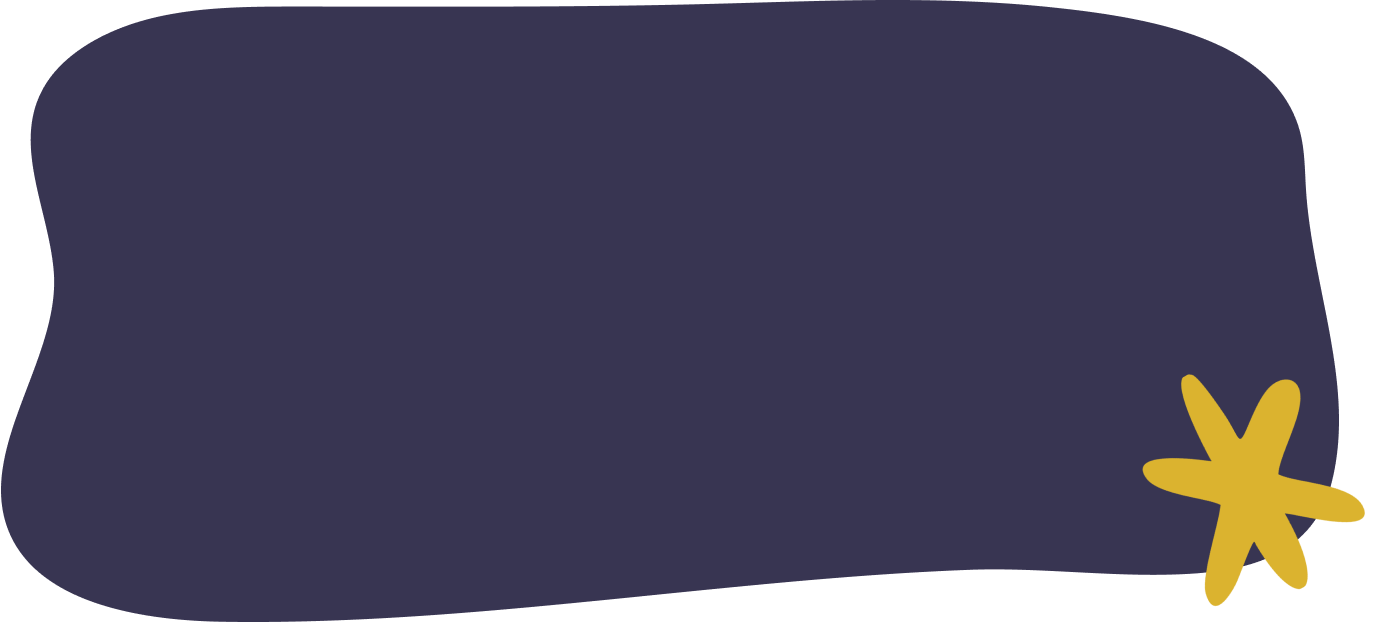
Visualize brown, papery pinecones; spring daffodils nodding their yellow heads in the breeze; grey, armored roly poly bugs; delicate ethereal spider webs sparking with morning dew; and bright red maple leaves that flutter to the ground in the fall.
Can you picture cheerful wind spinners making a breeze visible; homemade, hand painted birdhouses; colorful flowers in your grandmother’s garden, and a cheeky little gnome statue peeking out from behind a moss-covered log…what do all these things have in common?
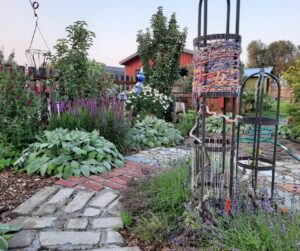
This garden offers high visual stimulation through variety of color, texture, form, pattern and other features.
They’re a feast for the eyes!
Sight is the way many of us interpret our world.
Through sight, we come to understand the place in which we live. We develop an interpretation and understanding of its characteristics, its visual properties.
We see and connect with our loved ones and with ourselves.
Children’s vision rapidly developed from birth until the age of 3. In that time, they become aware of, identify, and interpret things like shapes, colors, distance, and depth.
Children also build their vocabulary and social skills by naming and describing what they see. At the same time, they’re connecting with others AND with the natural world.
Nature itself offers seemingly infinite variety for us to observe and interact with through our sight. The patterns and colors of butterfly wings. Puffy, round dandelion seedheads. Light refracting off a pool of water. Dark spores on the underside of a fern leaf. Rainbows.
It would take me more than a lifetime to list all of nature’s incredible sights.
The more nature in a play space, the more variety of high-quality visual stimulation is present. Log rounds, chunky bark pieces, boulders, seed pods, flowers, grass stalks, water, sand, plants, and trees…again, the list is very, very long.
In a playscape, we can complement the natural world by incorporating different man-made shapes, forms, patterns, textures, and colors. We can provide additional visual elements to further capture children’s attention, inspire their imagination, and beg for interaction.
Some ideas for adding visually stimulating sensory features include a sculptural garden arbor with climbing vines, kinetic features like wind spinners, garden art and sculpture, colorful plantings, outdoor murals, and tools like a magnifying glass or magnifying station, kaleidoscope, or telescope.
How you create visual interest and experience is only limited by your imagination.
Nature offers the best kind of sensory stimulation! When plants are added to a children’s play area, the space literally comes alive.
Sensory plants are those that have particular qualities that engage our senses in different ways.
We’re talking about the sense of sight this week. Plants have different sizes, shapes, colors, and visual textures. Depending on how you use them, they can excite or soothe.
Rousing warm colors (red, orange, yellow) ‘advance’ visually, whereas calming cool colors (greens, blues, purples) tend to recede visually.
Massing plants, or planting them in greater quantities, gives a visual punch and draws the eye.
Plants with interesting forms are columnar, weeping, and twisted. You might use these plants as focal points or landmarks in the playscape.
Some plants and trees have interesting bark texture that invites a child’s touch. Add these where children can easily access them, like near a cozy space or along a path.
And, flowers, ooooooh the flowers. They come in infinite expressions of beauty. Kids love picking bouquets of blooms just to feel connected with nature’s dazzling drama.
Here’s a small sampling of plants that delight children’s sense of sight:
Paperbark maple, Acer griseum, hardiness zones 5-8
I have one of these small trees in our sensory garden. It’s greatest sensory trait is its flaking, curling cinnamon colored bark.
Approx. 25’ tall x 15’-20’ wide
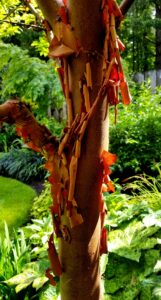
Paperbark Maple Photo credit: the beautiful Vickie Devlaeminck
Harry Lauder’s Walking Stick, Corylus avellana ‘Contorta’, hardiness zones 3-9
With its gnarled, twisted branches, this small tree looks like it came straight out of a Tim Burton film!
8’ – 10’ tall and wide
Magical Gold Forsythia, Forsythia x intermedia ‘Kolgold’, hardiness zones 5-8
As winter makes way to spring, forsythia’s blooms are like radiant sunshine. This early bloomer brings cheer to any early garden. The flowers are also edible and can be used salads or made into jelly, syrup, and tea!
4’ – 5’ tall and wide
Dark Horse Weigela, Weigela florida ‘Dark Horse’, hardiness zones 4-8
This weigela (pronounced vie-gela) has dark purple-bronze foliage, which makes a beautiful statement itself, and is especially dramatic when paired with chartreuse- or blue-colored foliage plants. It has a long bloom season with its trumpet-shaped magenta flowers.
3’ tall and wide
Fanfare Blanketflower, Gaillardia x grandiflora ‘Fanfare’, hardiness zones 3 – 10
This is a plant that will excite your little ones with its incredible yellow, orange and red blooms. This blanketflower has unique petals, so plant it where children can inspect it, in a fairy garden, along a pathway, or nearby a sitting area.
12” high x 18” wide
Gladiator Allium, Allium ‘Gladiator’, hardiness zones 4 – 10
There are many choices of allium, but the one that makes the biggest statement is Gladiator. This bulb sends up a globe shaped flower that is like an exclamation point in the garden! Plant in clusters of 5 or more to make a real statement.
36” - 60” tall
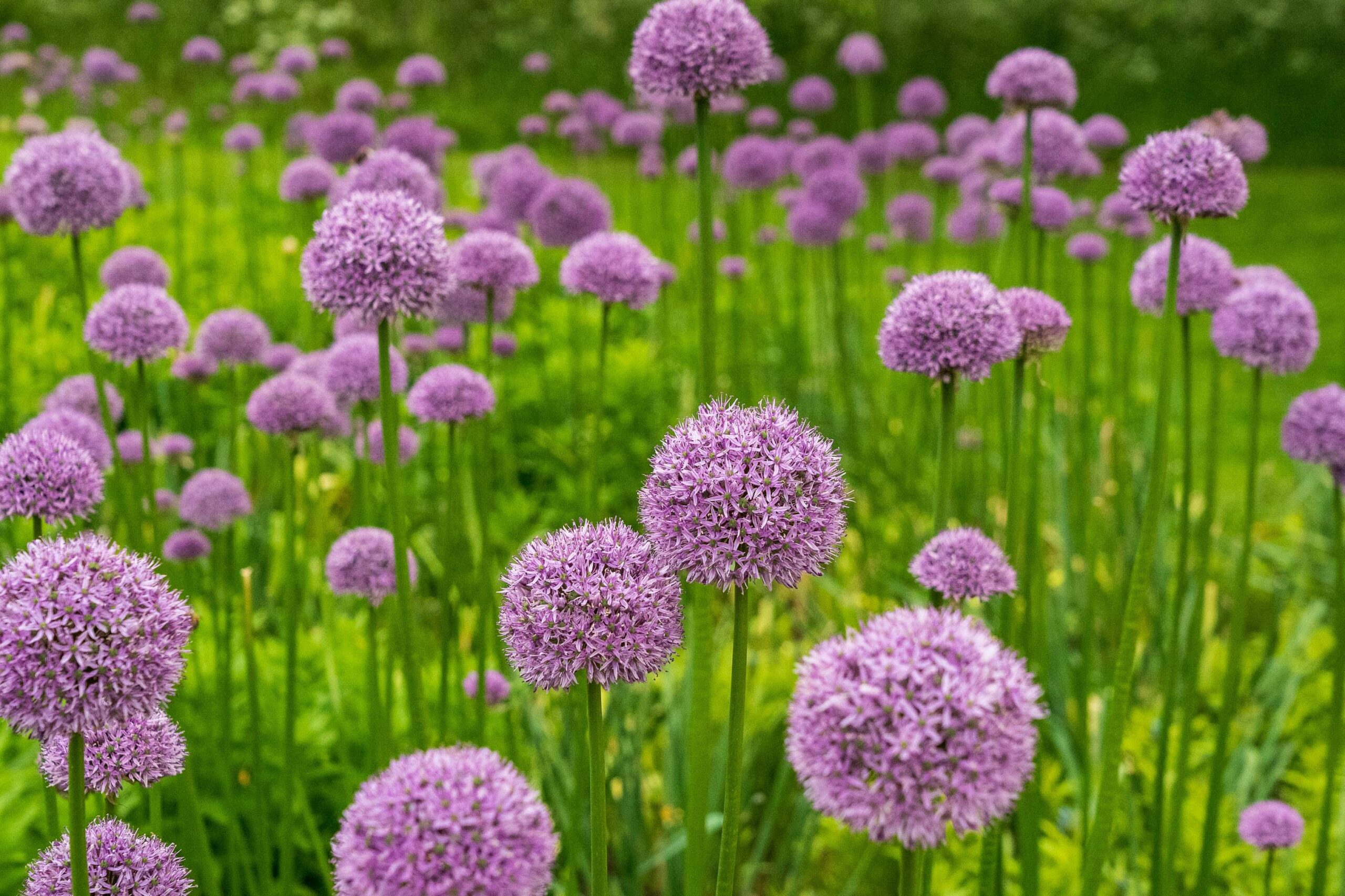
Allium Credit: Nick Fewings, Unsplash.
Purple Passionflower, Passiflora incarnata, hardiness zones 6 – 11
What can I say, there aren’t many blooms that rival the detail and uniqueness of a passionflower. This climbing vine is perfect for arbors, tunnels, and cozy spaces. Plant this where children have a chance to sit quietly and inspect this floral masterpiece.
12’ – 25’ long
Sunflower, Helianthus species, hardiness zones 4 - 9
To me, sunflowers are the “children” of the plant world. They’re full of life, innocence, sunshine, and cheer. My favorite uses of sunflowers are ‘sunflower houses’. Plant sunflower seeds in a circle, approximately 5’ – 6’ diameter. As they grow, they can be guided to arch together to form a vegetative hut (cozy space).
Heights vary
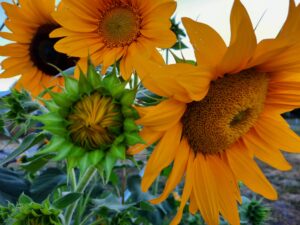
Sunflower
As always, be sure that all plants in the play area are non-toxic (there are a lot of online resources available to confirm a plant’s nontoxicity).
Also, pesticides, herbicides, and other harmful chemicals should NEVER be used in play areas. Children, especially those experiencing neurodiversities, are more vulnerable to the harmful effects of environmental toxins than adults.
Now that you have some ideas for enhancing the visual interest of your kids’ play and learning space it’s time to take action. Pick one thing that you know your kids would love. Better yet, have them pick one thing! Make it a fun family project and you’ll all benefit.
Wishing you the very best in creating a beautiful play and learning space for your kiddo!
Check out my eBook, Nature Play for the 7 Senses: A Parent’s Guide for Natural Play & Learning Spaces for ALL Children
